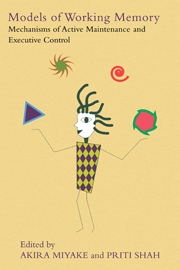Book contents
- Frontmatter
- Contents
- List of Contributors
- Dedication
- Preface
- Ode on Working Memory
- Acknowledgments
- 1 Models of Working Memory: An Introduction
- 2 Working Memory: The Multiple-Component Model
- 3 An Embedded-Processes Model of Working Memory
- 4 Individual Differences in Working Memory Capacity and What They Tell Us About Controlled Attention, General Fluid Intelligence, and Functions of the Prefrontal Cortex
- 5 Modeling Working Memory in a Unified Architecture: An ACT-R Perspective
- 6 Insights into Working Memory from the Perspective of the EPIC Architecture for Modeling Skilled Perceptual-Motor and Cognitive Human Performance
- 7 The Soar Cognitive Architecture and Human Working Memory
- 8 Long-Term Working Memory as an Alternative to Capacity Models of Working Memory in Everyday Skilled Performance
- 9 Interacting Cognitive Subsystems: Modeling Working Memory Phenomena Within a Multiprocessor Architecture
- 10 Working Memory in a Multilevel Hybrid Connectionist Control Architecture (CAP2)
- 11 A Biologically Based Computational Model of Working Memory
- 12 Models of Working Memory: Eight Questions and Some General Issues
- 13 Toward Unified Theories of Working Memory: Emerging General Consensus, Unresolved Theoretical Issues, and Future Research Directions
- Name Index
- Subject Index
8 - Long-Term Working Memory as an Alternative to Capacity Models of Working Memory in Everyday Skilled Performance
Published online by Cambridge University Press: 05 June 2012
- Frontmatter
- Contents
- List of Contributors
- Dedication
- Preface
- Ode on Working Memory
- Acknowledgments
- 1 Models of Working Memory: An Introduction
- 2 Working Memory: The Multiple-Component Model
- 3 An Embedded-Processes Model of Working Memory
- 4 Individual Differences in Working Memory Capacity and What They Tell Us About Controlled Attention, General Fluid Intelligence, and Functions of the Prefrontal Cortex
- 5 Modeling Working Memory in a Unified Architecture: An ACT-R Perspective
- 6 Insights into Working Memory from the Perspective of the EPIC Architecture for Modeling Skilled Perceptual-Motor and Cognitive Human Performance
- 7 The Soar Cognitive Architecture and Human Working Memory
- 8 Long-Term Working Memory as an Alternative to Capacity Models of Working Memory in Everyday Skilled Performance
- 9 Interacting Cognitive Subsystems: Modeling Working Memory Phenomena Within a Multiprocessor Architecture
- 10 Working Memory in a Multilevel Hybrid Connectionist Control Architecture (CAP2)
- 11 A Biologically Based Computational Model of Working Memory
- 12 Models of Working Memory: Eight Questions and Some General Issues
- 13 Toward Unified Theories of Working Memory: Emerging General Consensus, Unresolved Theoretical Issues, and Future Research Directions
- Name Index
- Subject Index
Summary
FIVE CENTRAL FEATURES OF THE THEORY
(1) We define working memory in terms of its function, namely maintaining efficient selective access to information that is needed to complete a given task. This function can be achieved in everyday skilled performance by a wide range of different mechanisms. In contrast, traditional short-term working memory employs only a small subset of those alternatives.
(2) The amount of information that can be maintained in accessible form in working memory for a specific task is not limited by a fixed capacity. As part of the extended skill acquisition necessary to attain very high levels of performance, experts acquire knowledge and skills to rapidly encode information in long-term memory such that the information can be efficiently accessed with retrieval cues (longterm working memory or LT-WM) whenever it is later needed to complete the task. Similar acquired mechanisms mediate the large working memory in skilled everyday performance.
(3) LT-WM is mediated by associative recall from long-term memory, and to function reliably it provides different types of mechanisms for overcoming the problems of interference resulting from repeated associations to related retrieval cues.
(4) LT-WM reflects a complex skill acquired to meet the particular demands of future accessibility for information with tasks within a particular domain of expertise. Domain-relevant skills, knowledge, and procedures for the task are so tightly integrated into the skills for encoding of information that the traditional assumption of a strict separation between memory, knowledge, and procedures is not valid for skilled performance.
[…]
Information
- Type
- Chapter
- Information
- Models of Working MemoryMechanisms of Active Maintenance and Executive Control, pp. 257 - 297Publisher: Cambridge University PressPrint publication year: 1999
Accessibility standard: Unknown
- 86
- Cited by
